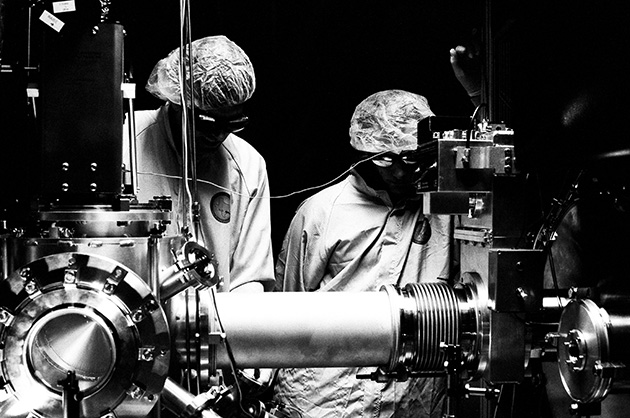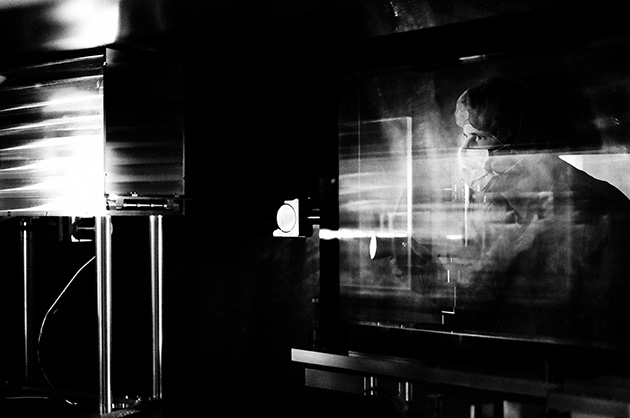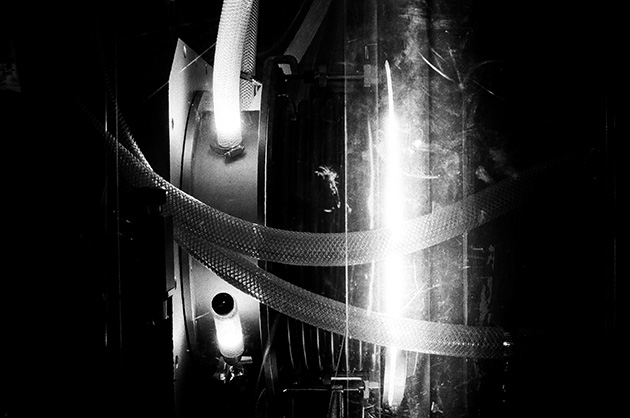1,000,000,000,000,000 Watts
Or, the Secret of the Big Beam.
Photography by Robert Shults
If you descend two stories beneath Robert Lee Moore Hall, down into the basement, and stroll through a dim corridor covered in faded safety posters—several of which display “DANGER” in large, red letters—you’ll eventually find yourself face to face with a set of brown double doors emblazoned with “Texas Center for High Intensity Laser Science.” Behind those doors, once an hour, for the briefest instant, shines one of the brightest lights in the universe: the Texas Petawatt Laser.
The Texas Petawatt Laser, known around these parts as simply “the Petawatt,” was fired for the first time in 2008, and until recently, in true “everything is bigger in Texas” fashion, it ranked as the most powerful laser in the world. Inside, physicists create some of the most extreme states of matter, spawning nuclear fusion, accelerating particles to 99.99999 percent the speed of light, or replicating conditions usually reserved for exploding stars.
On the day that I visit the Petawatt, a team of physicists from Germany is zapping microscopic spheres. One at a time, they magnetically levitate these orbs, each poor particle unaware that it’s about to meet the standard fate of things placed in the crosshairs of the Petawatt’s immensely powerful beam: complete and utter destruction.
To say that the Petawatt is powerful doesn’t really do it justice. In terms of pure energy, the beam carries (only!) as much energy as a pro tennis player’s serve, but that energy is focused and compressed onto the most miniscule of points in an unfathomably short amount of time.
If you were to envision the focused pulse as a bullet of light, it would be only as wide as a red blood cell, and the entirety of it would zip by in just 150 quadrillionths of a second. To put that number in perspective, that’s about as much time as it takes light, the fastest thing there is, to travel just half the thickness of a piece of paper. Squished and focused, for a tenth of a trillionth of a second, the laser delivers more power than is produced by all the electrical plants in the world put together.
The laser itself is a sight to behold, a basement-sized Rube Goldberg machine made of countless mirrors, metal tubes, and mysterious boxes with wires sticking out. Generally speaking, a laser is a carefully directed beam of radiation given off by “excited” atoms, which is to say their electrons are holding onto extra energy, which they then emit as a burst of light. But as Mike Donovan, associate director of the Petawatt, tells me, the real secret doesn’t lie in how they make the beam, but how they amp it up.
Each Petawatt pulse begins about a billion times less powerful than when it will meet its target, born at one end of the long room inside an off-the-shelf laser. Next, inside the amplification chambers, the beam of light must be stretched and widened by hundreds of times to keep it from burning the pricey optics. This is where the physics magic happens. Inside each chamber are slabs of pink-hued glass, embedded with an element called neodymium. As the laser pulse travels through this glass, the neodymium hands off its own energy, giving the beam a turbo boost. After amplification, special reflector plates narrow the light in both time and space for its final destructive rendezvous inside the target chamber. That chamber is built behind three-foot-thick concrete blocks to keep out radioactive blast waves, and must be kept in a vacuum so that the Petawatt blast doesn’t ignite the air itself.
Researchers around the world line up for months for a chance to use this unique international asset, and for good reason. Fields like astrophysics, long plagued by an inability to replicate the extreme corners of the universe in the lab, can now summon a supernova blast wave with the push of a button, which, sadly, is not red.
What’s a scientific instrument like this worth? Chief of operations Mikael Martinez estimates the Petawatt beam passes through $2 million of glass alone, but it’s hard to put a price tag on such a rare machine. Interestingly, much of the Petawatt’s equipment was recycled from older lasers, like Lawrence Livermore’s defunct Nova laser. “It’s a world-class laser facility using old technology and free equipment,” Martinez explains. “Like grafting a leaf.”
If there’s something about the Petawatt that seems mysterious, you’re not alone. Photographer Robert Shults captured that magical mood in this photo series “The Superlative Light.” For Donovan, the Petawatt’s beauty lies in the science that it illuminates.
“The more you know, the more beautiful it gets,” he says.
Top: Woosuk Bang, PhD ’12, prepares his doctoral thesis experiment on the Texas Petawatt Laser. Earlier experiments with terawatt class lasers proved that clusters of gaseous molecules could be converted into ion energy. Bang’s experiment, the first to be conducted with the Texas Petawatt, created an ion plasma of sufficient temperature and density to catalyze neutron fusion reactions.
Above: Gilliss Dyer, PhD ’07, and laser technician Ted Borger at the Texas Petawatt lab. During experiments, the target chamber bristles with sensors and imaging devices, all synchronized to the laser’s ephemeral pulse.
A technician examines a beam dump within the Texas Petawatt compressor chamber. This device effectively stops the laser light in its path by employing a pair of low-transmission mirrors. As the beam is reflected between these optics, its luminance is reduced with each pass, eventually reaching a negligible energy level.
Borger observes computer images of the beam within the laser’s diagnostic area. The pulse is diverted into this cleanroom prior to amplification for inspection of the laser’s intensity, timing, and wavelength synchronicity. The use of dark curtains helps the scientists examine a beam consisting largely of wavelengths outside the range of human vision.
A scientist secures his hood before entering the target bay cleanroom. Hairnets, gowns, and masks are standard equipment within the Petawatt facility. The most serious concerns regarding environmental cleanliness exist within the compressor and target chambers, where even the smallest contaminant can dramatically affect the beam’s uniformity.
The view outside one of the Petawatt’s main amplifiers during a system shot. Massive discs of neodymium phosphate glass retain energy from intense bursts of white light produced by flash bulbs inside the amplifier casing. During full-power shots, the laser pulse passes through these discs four times, gathering the energy stored within the glass.
See more Petawatt Laser photos in Robert Schults’ forthcoming book, The Superlative Light.
Below, watch a Longhorn Network Alcalde Show segment on the laser and Schults’ work:





